Enjoy DatePsychology? Consider subscribing at Patreon to support the project.
Many of you will have seen this chart:
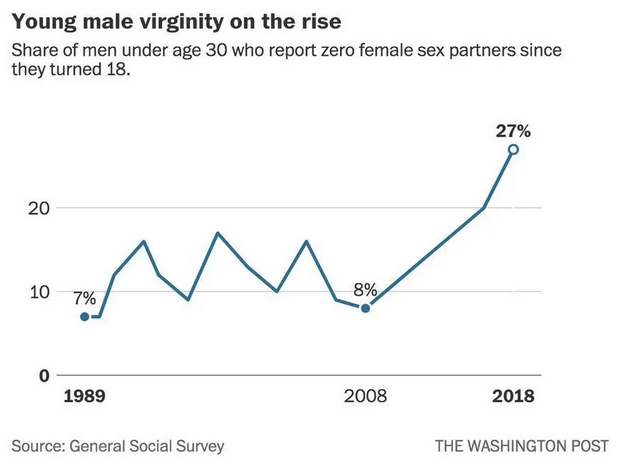
This is from the General Social Survey (GSS) in 2018, as reported by the Washington Post. This image has become a meme. This was released in 2018 and the data was collected in 2017. Six years later, it’s still floating around. We have updated GSS data that is from 2021, a little bit newer, which I have written about before. Nonetheless, I wanted to go back and revisit this meme stat.
Having dug through the GSS variables, I don’t see one that measures virginity. This seems to be based on the NUMWOMEN variable, which asks this question:
Now thinking about the time since your 18th birthday (including the past 12 months) how many female partners have you had sex with?
It’s probably a pretty good proxy for virginity, but it will underestimate it some. According to the US Census, about half of men are not virgins at age 18. Every 18-year-old who had sex at 17, but not past their 18th birthday, will be counted as a “virgin” if we interpret it this way. Nonetheless, let’s take it at face value going forward. We’ll go ahead and call it virginity for this article.
I took the GSS data and filtered by male sex, heterosexual, and age 18-30. I also applied the GSS recommended weighting variable for proportionally representative data. After weighting with the Survey package in R, this is what I got:
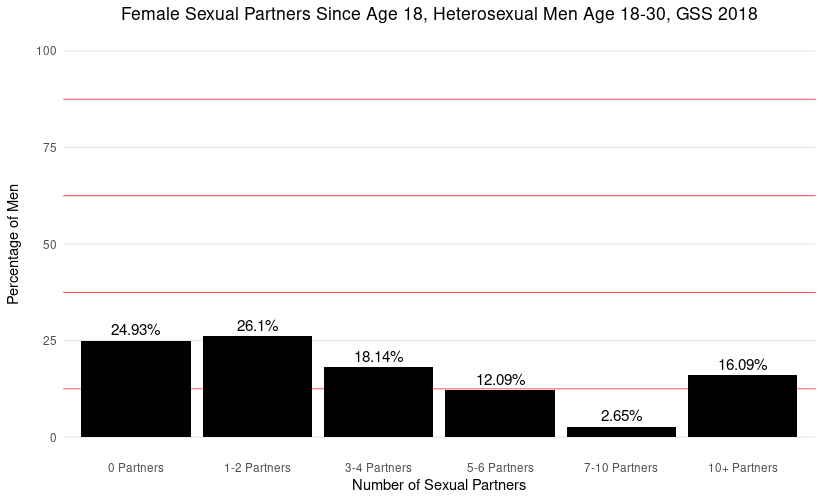
In this, 24.93% of men are “virgins.” My number is a little lower than the WaPo chart. I don’t know how the Washington Post analyzed the data. It could be because I excluded non-heterosexual men. It could also be because I included men who were 30 years old (it is unclear if the WaPo stopped at 29). Whatever the case may be, we’re pretty close nonetheless.
Then I split the data by age groups. Here is the result:
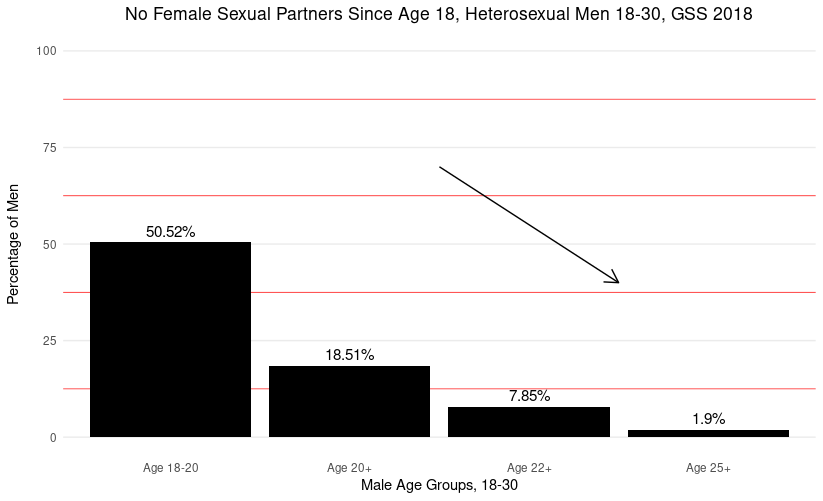
This shows a very strong effect of age on male virginity. In this, 50.52% of men between 18-20 are virgins. For men over age 25 (but not older than 30), only 1.9% are virgins.
I have seen the WaPo chart interpreted untold times by people who think it means that 27% of all men aged 18-30 are virgins. 27% is across the whole group. It’s a highly skewed distribution, with the vast majority of virgins falling into the youngest age cohort.
In other words, it’s really quite normal to still be a virgin at age 18. It’s very uncommon to be a virgin at age 25. Indeed, the more conservative or traditional elements of society might have argued at one point that you should still be a virgin at age 18. At age 18 you probably have very little going for you. You might still look very young (not especially attractive to women). You probably don’t have a job, an education, or money. Indeed, there is a current phenomenon of extended adolescence; young men are getting drivers’ licenses, jobs, and entering university later in life. They are living at home with their parents longer. Lots of reasons to remain a virgin.
Here is the trend of virginity in the GSS between 2008 and 2018, by age group:
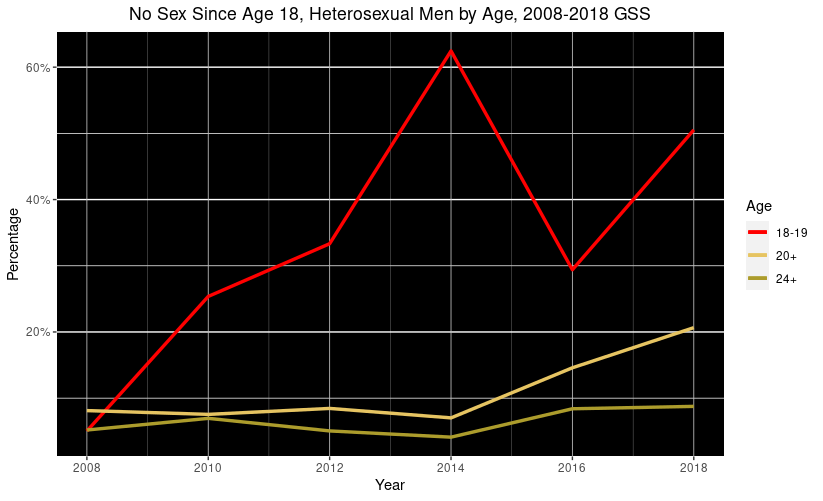
You do see an uptick in virginity for the older age groups. However, most of the effect is driven by the youngest cohort. Additionally, when breaking the sample into age groups the 18-19 year cohort only has 10-20 participants for each year. The other age groups have 100+ participants across years. This contributes to the high variability that you see in the chart for the youngest men. The data is noisier and weighting a small sample means that you are also weighting the noise.
Now we can compare with 2021, the more recent data:
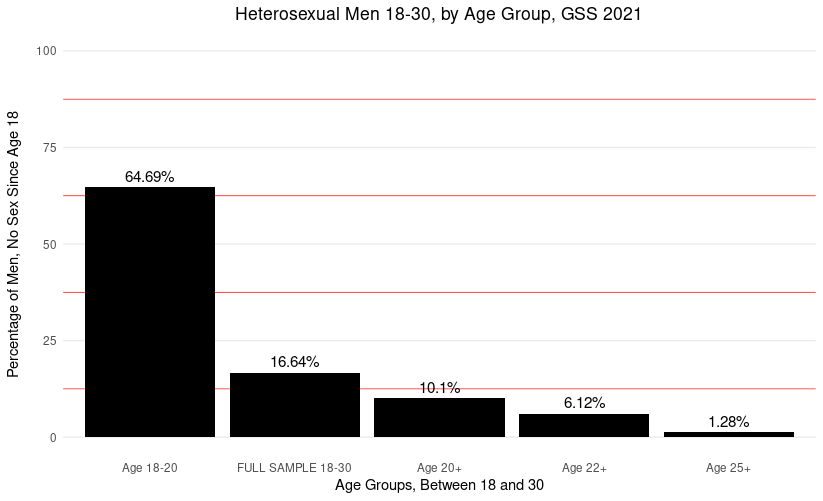
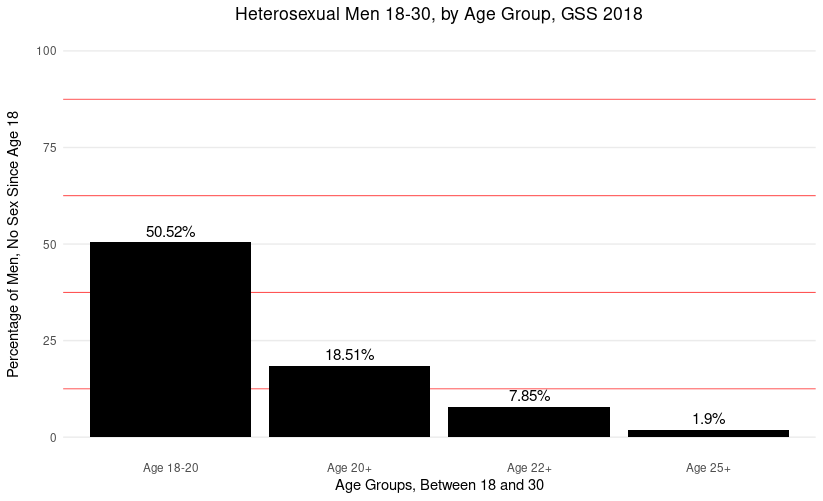
We see a decrease in male virginity for men over age 20 and an increase for men under age 20. Consistent with the extended adolescence observation. Keep in mind the percentage across the full group was 24.93% in the first chart; in the second it is 16.64%.
Here we can add our 2021 datapoint to the yearly plot:
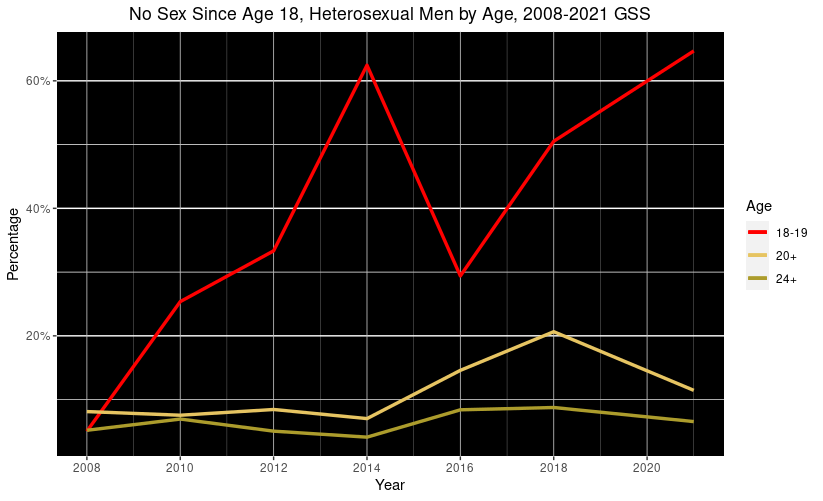
Better Data: The NSFG
As I wrote in the previous section, the 18-19 age bin only has 20 subjects. This is too small; it will produce a high margin of error. This is likely why you see such high variability from year-to-year. The GSS uses a weighting variable to make disproportionate sample numbers representative of the population. We might want to look at a larger dataset for the youngest adults.
Additionally, the GSS asked how many people had not had sex since age 18. This has been interpreted as virginity (for example, in the first chart in this article). However, many people do have sex before age 18.
The National Survey for Family Growth (NSFG) asks who has ever had sex and has a sufficiently larger sample for young adults (N = about 1,700 for men in 2017-2019 NSFG; the GSS subsample only had about 120 for comparison). Here are some charts from @nuance_enjoyer on Twitter (follow him if you use Twitter; he is really doing a great job with the data on sexual and relationship topics).
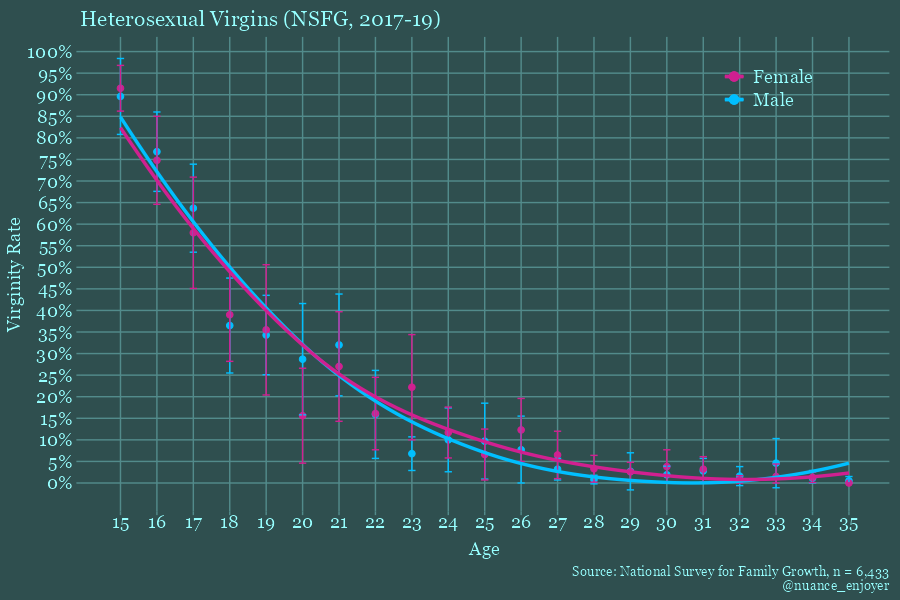
Here we see the percentage of heterosexual virgins of both sexes by age. The trend is similar. We see a sharp decline in virginity that becomes pretty stable after age 25.
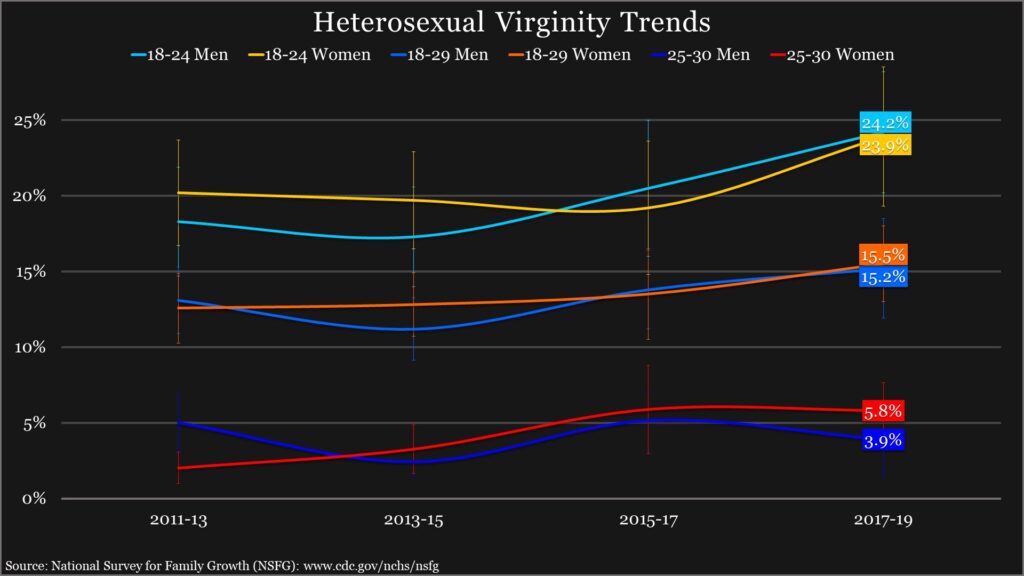
Here is a plot by time and binned by age group. This shows the same trend. There is a small increase in virginity in the most recent range of years. The youngest adults are more likely to be virgins, but most will not remain virgins. By age 25-30 3.9% of men and 5.8% of women will remain virgins.
Conclusion
The virginity statistic is driven by the youth. We don’t see an increase in extended male virginity between 2018 and 2021, although we did see an uptick between 2014 and 2018. Past age 25, very few men remain virgins. The question used in the GSS that has been interpreted as “virginity” probably overestimates it a little bit. Additionally, the small number of young male adults in the GSS contributes to high variability across years.
Nonetheless, what we see is pretty normal and maybe even good. As young as I can remember, early and risky sex has been discouraged in sex education. Now we are finally seeing a modicum of abstinence (this is true for women as well) and people are losing their minds.
Why are young men having less sex?
Part of what drives this may be due to prolonging relationships. Despite promiscuity narratives in our folk psychology, most sex occurs within the context of a relationship. Additionally, the recent Pew survey of singles found that approximately half of single young men between age 18-30 reported being voluntarily single. As people extend adolescence and prolong the formation of serially monogamous or long term relationships, sexlessness will increase for the youngest cohort. Additionally, women date up in age on average. While young men can’t date down (or they would be dating children), young women can date up, and this leaves an imbalanced sex ratio for the youngest cohort.
People are also socializing in person much less. Many of you who will read this are very young. You may be in the 18-20 demographic and it may feel like there is a sex drought. No one is having sex! Totally normal for your cohort. As you improve in your physique, your career, and your education, you will find that you’re probably not all alone at age 25.
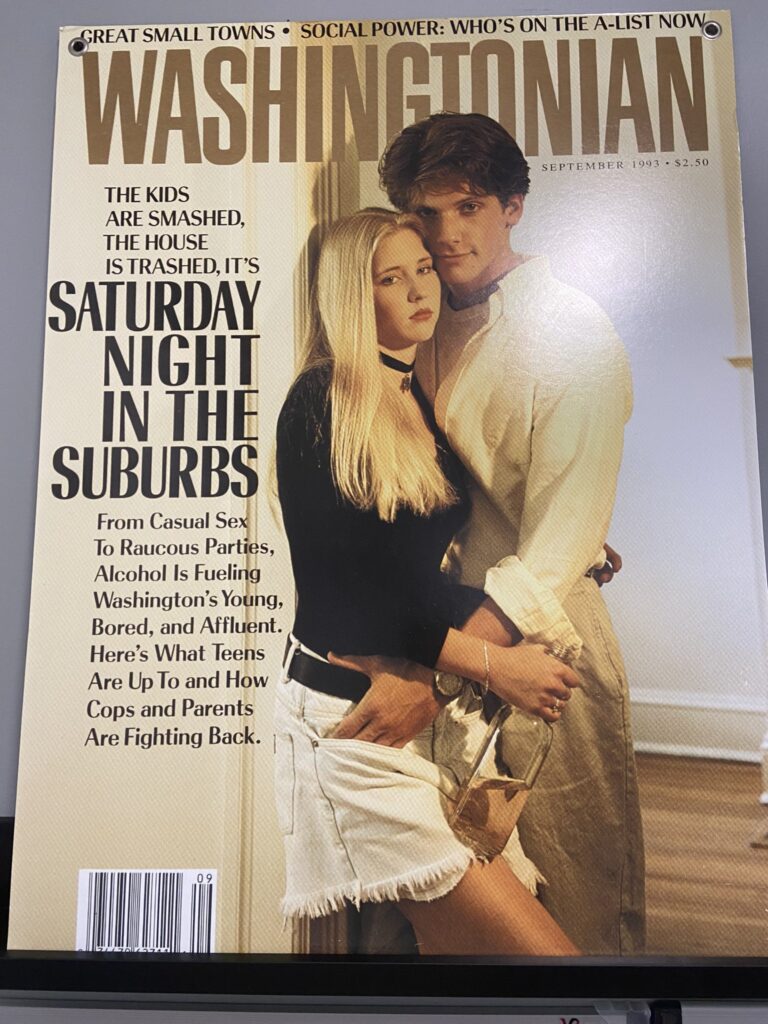
Additionally, alcohol consumption and online socialization has increased, while in person socialization has decreased. In the 90’s, alcohol use and house parties were a mini crisis. Boomers panicked at young adults and teenagers going to parties, drinking, and having causal sex. We had people come to our schools to discourage it. Even today, about 60-70% of all casual hook-ups involve alcohol (Garcia et al., 2019). Alcohol use also predicts earlier sexual initiation and a higher number of total lifetime sexual partners. South and Lei (2021) found that the decline in alcohol use explained 30% of the variance in lower rates of casual sex for young men. Further, playing video games explained an additional 25% of the variance in the decline of casual sex. Young adults who are more oriented to a short versus long term mating strategy are also more likely to binge drink (Vincke, 2017).
What is happening? People are staying indoors, socializing online, and engaging in hobbies that don’t put them into physical contact with other individuals. The youth are not going to house parties, getting drunk, and having casual sex like they were in the 90s. People are getting their social interaction and dopamine hits in ways that don’t force them to go out into the real world.
This is part of a broad trend in the decline in adolescent risk behavior (Ball et al., 2022). It is explained in large part by less in-person interaction. We see declines in juvenile crime, alcohol use, drug use, and other risk behaviors. Additionally, we see a decrease in young adult employment and, for young adults in school, and increase in time dedicated to school work.
Here are results from a representative Gallup poll. This shows the decline in the size of friend or peer groups. Having a large peer group would have been essential the past decades for meeting potential mates.
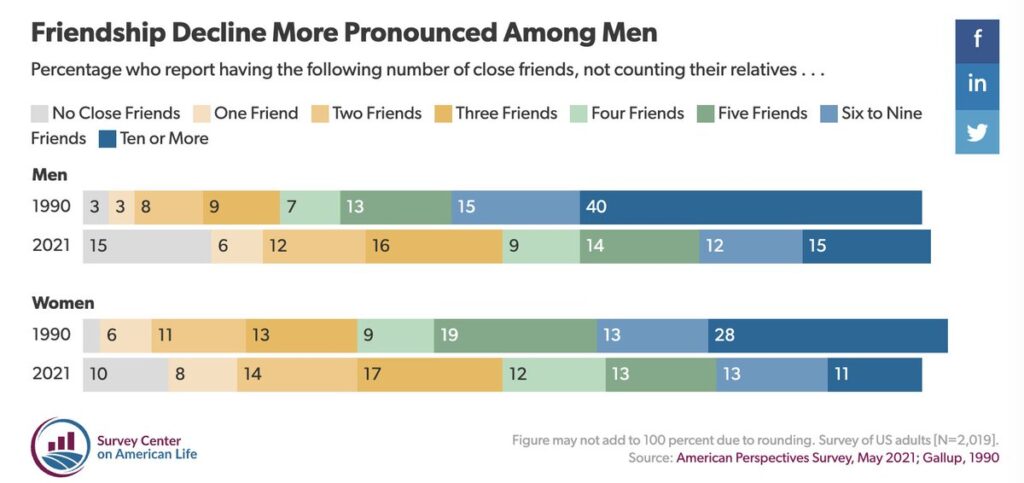
And similarly, here we see a trend in extended adolescence across multiple domains, including going on dates:
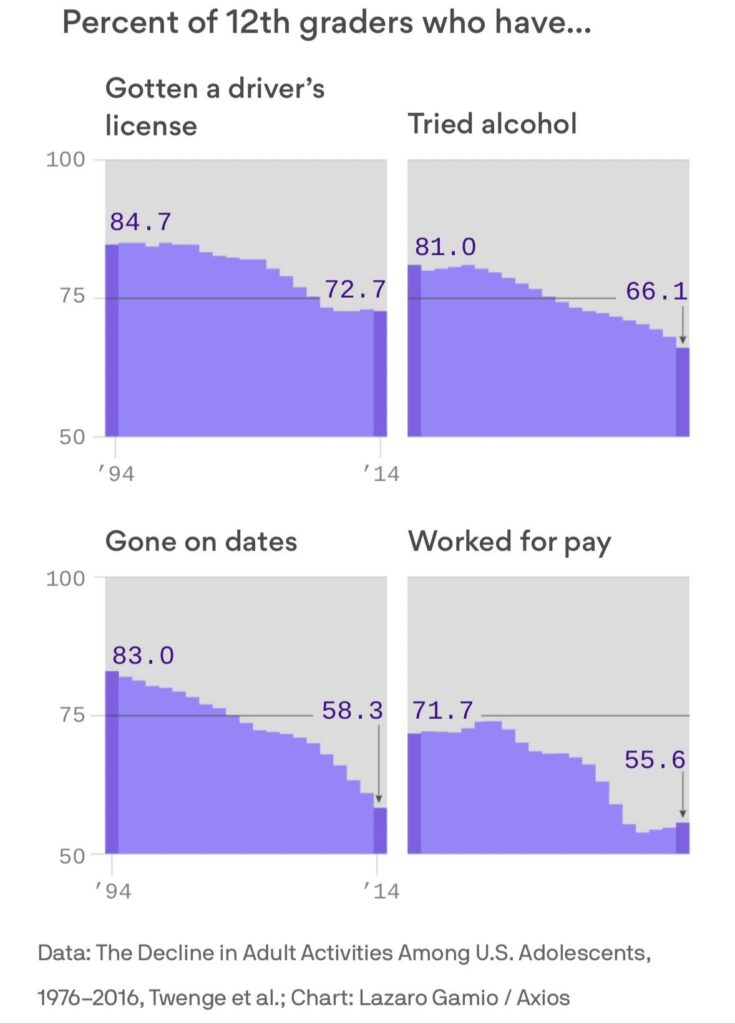
A popular explanation for young men having less sex is that someone else is stealing all the women. Further, that online dating (Tinder) drives this. In essence, that “Chad” is monopolizing all of the women. On the one hand, women date slightly up in age, so there is an effect where other men are making it difficult for the youngest men. This has always been the case. Age 18-20 is a rough age for men to date. The early 20s have been called a “loneliness gap” in male psychology. It is not a new phenomenon.
What about Tinder and online dating? This deserves a whole article, but I will leave you with a recent study by Berkeren et al. (2022). This was a longitudinal study of 1.3M college students following the Tinder rollout. Greek fraternity members (perhaps where you might find the “Chads”) saw a 6% increase in total sexual partners. Further, STDs (a good measure of sexual activity in a population that does not rely on self reports) only increased by 0.2%. The top 25% of men saw an increase in sexual partners by 4.3%. The average number of sexual partners in that top 25% of college students, by the way? It was 2. Two sexual partners annually. The median number of partners was 1, the same as the bottom 75% of men.
Did Tinder have an effect? Perhaps. It doesn’t seem to be large, however. Certainly not enough to explain half of the youngest adults being without sex. The results are also inconsistent with the so called “80/20 Rule,” or the belief that 20% of men are having sex with 80% of women.
Perhaps unsurprising, given that more recent research has also shown most people use dating apps to find relationships, rather than to find casual sex (Castro & Barrada, 2020).
References
Ball, J., Grucza, R., Livingston, M., Ter Bogt, T., Currie, C., & de Looze, M. (2022). The great decline in adolescent risk behaviours: unitary trend, separate trends, or cascade?. Social Science & Medicine, 115616.
Buyukeren, Berkeren and Makarin, Alexey and Xiong, Heyu. (2020). The Impact of Online Dating Apps on Young Adults: Evidence From Tinder.
Castro, Á., & Barrada, J. R. (2020). Dating apps and their sociodemographic and psychosocial correlates: A systematic review. International journal of environmental research and public health, 17(18), 6500.
Garcia, T. A., Litt, D. M., Davis, K. C., Norris, J., Kaysen, D., & Lewis, M. A. (2019). Growing up, hooking up, and drinking: A review of uncommitted sexual behavior and its association with alcohol use and related consequences among adolescents and young adults in the United States. Frontiers in Psychology, 10, 1872.
South, Scott J., and Lei Lei. “Why Are Fewer Young Adults Having Casual Sex?.” Socius 7 (2021): 2378023121996854.
Vincke, E. (2017). Drinking high amounts of alcohol as a short-term mating strategy: The impact of short-term mating motivations on young adults’ drinking behavior. Evolutionary psychology, 15(2), 1474704917707073.
25 comments
I think you totally forgot about the existence of online pornography.
Being a virgin past 25 is not uncommon.
I’m happy to see a more detailed breakdown of this claim and data, but not happy to see my cohort drop from 27% to 1.9%.
A very interesting and well put together analyses.
However I’ve got one question. Why does it seem like the data in your line charts and those in you bar graphs differ? In the line chart it looks like the 2018 GSS found that ~20% or 21% of men 20+ (to 30) did not have sex since 18, while you bar graph says it’s 18,51%. That seems a little odd to me.
Hi 21%is for 18-30 male virginity in 2018
18% is for 18-30 male virginity in 2021
Hope it helps
Wait you are right
Better ask Alex @Alexadra
I mean does these redpillers and alt right really research history of marriage? They seems to support traditional value. Let’s observe some traditional societies.Ancient Germanic tribes male averagely lost their virginity at 21yos females are slightly younger than them according to tacitus. In medieval Christian societies, men lost their virginity through marriage around 24-27. Women are like 21 yos for west Europe 19yo for south Europe. In Islamic societies age gap is wider, women are like 16-19 yos and men are 27-30yos in18–19th centuries. If we take lifespan as consideration. Modern men actually performed better than their ancestors. I am not a fan of sexual liberation society. But I am not surprised many young males are virgins because it’s a historical norms. It’s funny they are fussing about it, thought it could be better when the society is ultra traditional. It’s only better when it comes to virgin wife, but many men back then are virgins before marriage .
I think my friend Archie Spokes is a Chad.
This article proudly brought to you by Modern Feminists, “Men do not engage in intimacy out of choice” is pure misinformation.
Despite many modern world renounced psychologist like Dr Peterson keep proving otherwise.
I don’t blame the author because the only way you can publish anything in the media today is to follow the same rhetoric, men have it made and anything they don’t achieve including finding happiness is due to their own choice or negligence, you say this in an age when young men suicide rates are through the roof and men have no where to turn to.
I know you are going to Block and Report this comment but let me enlighten your bias research
> Men today don’t want to have sex because they are told “masculinity is toxic”, so their are struggling to understand why a huge part of their identity is being labeled as oppressive and manipulative.
>Men are virgins because they don’t want to be falsely be accused of abuse or rape without any evidence.
>Men are virgins because social media continuously posts unreal expectations for men in romance and relationship without reciprocity from women.
>Men are virgins because even the most average looking woman is the “table” and if a man wants to even look in her direction he needs to make 6 figures, be at least 6 ft tall, and 6inches, he needs to live and breath only to romance a woman day any night.
>Men are virgins because the average girl their age has had exponentially more partners than him and does not value intimacy the same as him
>Men are virgins because they live in a world that tells them they can’t have any preference or standard that does not match a woman’s life choice including body shape, profession (onlyfans) etc
Your research is a disgrace
Renowned benzo addict Jordon Peterson whose day job is spending time arguing with teenagers on Twitter.
If this blog’s author is a mordern feminist than Jordon Peterson is a incel king.
Only a certain type of masculinity is deemed “toxic” not masculinity in of itself. Modern progressive liberal men’s masculinity is praised highly by feminists and other progressive men. Men are reclaiming what was lost to the patriarchy with a much more positive view of masculinity as a healing and constructive form of how we act/feel.
False accusations are at maximum 8% of all rape cases investigated. Men and women don’t choose much of their lifestyles based on 8% chances of something bad happening. Most of us look at the 92% chance of getting happily laid as something to look forward to.
Most men around the world don’t make 6 figures, the average male height in every country is below 6 foot, and cock sizes range on average from 4 to 8 inches globally. Most men globally are dating and marrying and roughly the same kinds of rates as men in the 80s and 90s, with a small dip in these stats as society has moved towards cohabitation over flat out marriage.
Again in every single survey of male and female and nonbinary people’s sex lives, women have on average LESS partners than males. Now you may claim “well but if they wanted to… they could be getting different dick 3 times a week for years!” Well, that’s a cute whatif scenario that just doesn’t happen for most women. Women as a group don’t want different dick 3 times a week for years then settle for a ‘betabux’ dude. Most women want to be with 1 person for a very long time, and are extremely(I’d argue TOO selective) selective about who they date and give up their goods to.
If you’re desperate you shouldn’t be a chooser. Beggers should date whomever is out there that wants to date them. If you’re a virgin 26 year old nerd, you probably shouldn’t turn down dates from chubby/obese chicks, single moms, 50+ cougars, the thin girl with the weird hairdo/nose/facial scar/bad at makeup, etc. If you’re truly desiring companionship, then you’re gonna have to find someone that truly wants you for you. And its not going to be a 9/10 swedish model. Sorry.
“Modern progressive liberal men’s masculinity is praised highly by feminists and other progressive men.”
Arguably that isn’t masculinity at all, but a general list of positive characters Remove the so-called toxic traits from masculinity, like stoicism, and the it loses all meaning and descriptive power.
“False accusations are at maximum 8% of all rape cases investigated”
That’s actually shockingly high, considering false reporting for other crimes is 2% AND the low conviction rate. (Imagine if the legal standard for a conviction were lowered, or a presumption of innocence outright removed like some feminists have campaigned for.)
“6 figures, the average male height in every country is below 6 foot, and cock sizes range on average from 4 to 8 inches globally”
And a lot of people still live in grinding poverty, or in societies where women have no autonomy. Global statistics are misleading.
“If you’re desperate you shouldn’t be a chooser….”
Everyone has the right to preferences. Telling a 26 yo nerd to date a 50+ cougar is absurd.
Agreed. If these men are so lonely and they think women’s standards are too high, then they should go and date the women who WOULD take them (old ladies and fat single moms). They are certainly not entitled to be in a relationship with a woman whose standards they cannot meet. That young attractive skinny girl owes you nothing.
“Men are reclaiming what was lost to the patriarchy with a much more positive view of masculinity as a healing and constructive form of how we act/feel.”
Lmao. Feminist dogma. A good start.
There are no reliable stats on false/exaggerated allegations. Nor have you factored in the fact that true allegations are met with hugely punitive punishment. The criminal justice system is spectacularly biased against men and in favour of women, as documented by numerous studies. This extends into society in general. Misandry is normalised, misogyny is the gravest crime known to man. Men’s typical ways of hurting women are hyper-prosecuted, women’s typical ways of hurting men (lies/manipulation/false allegations/pregnancy/paternity fraud etc) are almost never prosecuted (criminally or socially).
Women hurl false allegations, and threaten false allegations, with impunity, and regularity.
But this isn’t the primary reason men are being deprived of sex/relationships/intimacy/etc. It’s because of social media. Social media has destroyed women, and globalised sexual interactions. Women used to select men from the small number of men they encountered in their day to day life. Now they select them from everyone within a 100 mile radius (and beyond). Thanks to Tinder/Instagram/TikTok, and so on.
Which means they select the best looking and highest status men. Then add the “liberation” of female sexuality. Much less so-called “slut-shaming”. Meaning no judgement for choosing men based on base characteristics, and no judgement for casual sex, no judgement for hookups, no judgement for “friends with benefits”, no judgement for “rosters”, no judgement for for being sluts. ie no controls on their sexuality.
Unlike men, who have more controls on their sexuality than ever before. Practically everything they do is “creepy” or “toxic” or “predatory”.
Thank you! The research is really bad and unscientific hope he stops before his grift really hurts people
Carla Gomera is completely right. Thanks for the true and honest words. Everything else is just a try to play down a serious issue.
18-30 is not an age group. There’s 18-24, 25-34, 35-44, etc. Late 20s and early 30s are APART OF THE SAME AGE GROUP
Well I lost my virginity at 34, so that anecdotal point invalidates all statistical research. Rheee!! Rheee!
🙂
The problem with this “reasoned” look at the “data” is that it’s missing the forest for the trees. First off the author of this article is a muscular man with a man bun and Viking beard that studies relationships. This guy is in the top 10% of desirable men. He has a socially desirable appearance and an attractive professional interest with high educational credentials. On top of that he has a social presence as a knowledgeable man. Taken together this man does not suffer as many of the social ills created by modern feminism as lower tier males. He has a contextual life experience which says, “these things are not that bad,” and so he seeks to find information that aligns with his experience. That isn’t to say things are as bad as lowest tier males make them out to be either, but it’s important to note that the authors point of view isn’t neutral to the topic he is covering and the way he interprets and relays his findings. Secondly, he ignores the larger social context that these events are taking place in. Even if men are ending virginity at roughly the same age as historical counterparts and also enjoying a relatively similar numbers of partners, etc., they (modern men) live in a vastly different society to those historical counterparts. A sexless 18 year-old male in medieval times is not a sexless 18 year-old male in 2024. Women in medieval times, moral or not, did not have the same rights, financial freedom, or agency as modern women. Medieval women were subordinate to a male (father, older brother, husband, etc.) and had limited social circles. Medieval women had little power to decide who their relationship partners would be. Sex carried huge risks for women and they may have engaged in some hanky panky with a local field boy but they’d have to be careful. An inappropriate pregnancy could carry huge social and health risks. So women in most cases were probably married off to a man known to the woman’s family through either familial or social bonds as a virgin or relatively sexually inexperienced. They would then come into the subordination of the man they were married to who in a lifelong pact. There was no such thing as rape in the context of the marriage so the husband could enjoy as much sex as he was willing to force on his wife. Overall you had a society where sex was relatively limited in acceptance, availability, and safety. So a medieval man or even 18th century man losing their virginity at 25 and having a relatively small number of sexual partners was fitting to socio-technological settings. Fast forward to 2016 or later and what do you have? A society where sex is seemingly ubiquitous. It is discussed, analyzed, displayed, and much safer to engage in. We have the pill, condoms, antibiotics, the internet, smart phones, social media, cars, plumbing, and on and on. Every aspect of our lives has accelerated in efficiency and ease. You don’t have to struggle to get food or water. You can do double the work in half the time of your predecessors. You can communicate instantly with people across the world and travel vast distances in a couple days. There’s also never been as many people as today. Moderately attractive single women are in every nook and cranny. These women are not limited by the same social, health, or lifestyle restrictions of their predecessors. They could engage in sex with multiple partners in the same day without fear of pregnancy or health consequences. It’s never been more socially acceptable for women to display and advertise themselves as sexually desirable and available. Women regularly walk around in virtual underwear, showing off every bit and bob, openly signaling their sexual characteristics. Some even go so far as to profit from their sexuality by selling visual access in the form of videos and images. Yet for its seeming availability men are only getting laid at the same ages and rates as men a thousand years ago. It’s the equivalent of being thirsty in the middle of an ocean: water water everywhere but not a drop to drink. The stark juxtaposition of the amount of sex seemingly available to men and the amount of sex men actually get is jarring. It’s a real slap across the face when a mid level man is denied sex or a relationship by a mid level woman when there is a significantly reduced set of consequences for women and how much women seem to be signaling their availability. This obvious reality is the source of bitterness of so many modern men. Comparing the sex lives of previous generations to modern day men only highlights the disparity. It doesn’t make it seem “normal” when “normal” for men was a nearly social guarantee of a lifelong sexual partner. One would expect, as with many other aspects of modern life, that mens sex lives would be dramatically superior. This analysis therefore falls somewhat short of addressing the reality. If taking the data as accurate it does the opposite of making the situation seem not that bad, as it might seem to someone like the author.
Agreed
https://www.wikihow.com/Male-Virginity
lots of newer studies in this article that the situation is getting worse, not better
It should also be noted that when the male celibacy rise began – in 2007 – that’s also when the first iphone came out and a lot of social media sites came online.
Last but not least – even if we disregard this data point, the fact that birth rate in western nations dropped to below 2 per woman, since late 1970’s and never rebounded should be of concern for all.
I just don’t get those Manosphere guys. In the beginning there were many, sexually inexperienced men that had either no or at least the wrong ideas how to attract women and weren’t able to step out of their comfort zones(!). Thus, they became angry to both women and society in general.
Then in the late 90s and 2000s some of these men banded together and created PickUp. To improve themselves, learn about social dynamics and how to attract women they shared their collective experience. In the end getting better with women is a skill that can be acquired through acquiring knowledge and hard work like any other skill in life.
We had a clear set of values, e.g.:
It’s not about getting laid; it’s about building a life.
Don’t slut shame.
Leave here better than you found her.
Always be clear about your intentions.
The methods and the terminology might look a bit unorthodox or weird to the uninitiated, but it gave the average nerdy loser, that thinks in a too logical way and is too much stuck in his head a framework to work with and fall back to, if they come in a situation, they feel uncomfortable or are not familiar with. This gave us the experience we lacked and the more success we had, the more natural the flow became, and we relied less on those crutches. And for those it targeted, it was easy to understand, since it was written in their (nerdy, logical) language. In my opinion, this was beneficial both for the guys and the girls. I am a father and about to hit 40 now and I can confidently say that those two lovely girls I call my daughters would have never been born it wasn’t for the wise teachings of the masters of old like Juggler, David DeAngelo, VinDeCarlo, Jordan Harbinger or their respective counterparts in the German community that I was part of.
Around ~2010 I noticed a shift. Those that made money in the community as coaches and/or influencers realized that people are lazy and that they don’t want to put effort in and especially don’t want to step out of their comfort zones. So, the narrative shifted from self-improvement to the red Pill where it was now the fault of feminism and society, that these men were lonely. So now we have come full circle and young men are again angry to both women and society in general, but they now have a clear bogeyman in “wokeness” or “feminism” and are better organized on the internet so they can cry together. There may be grains of truth to those teachings (I personally believe that men and women have it easier in different areas of their life in different age groups). But the world is never fair and the best thing you can do is analyze your personal situation and your behavior and see what you can to t improve it. A good example is Rollo Tomassi. His Year 1 stuff was brilliant. Beginning with Year 2 it got worse with every essay until it transformed into the complete manosphere package of BS. I don’t know if he really is this bitter, but he probably realized which content gets more clicks and makes him more money.
The Black Pillers are even worse. If you truly believe that looks are the only discerning factor in (male) relationship success, then what the fuck is stopping you from taking care of your wardrobe and getting buffed yourself? This just requires getting your ass up from the couch, hitting the gym and eating healthy. It’s an easy thing to do, since it does not require you to step out of your comfort zone at all. Who knows, down the line your own training progress might even give you the confidence boost you needed to attract a woman.
You speak like someone looking front he outside in and not an actual manosphere regular. Don’t speak on groups if you aren’t part of it or at the very least we’ll researched. The amount of shaming language and blatant misinformation is hilarious. Use sources and update your talking points. It sounds like your talking about the manosphere circa 2008 lol.
https://www.wikihow.com/Male-Virginity
this article includes a lot of data from 2021 studies – unfortunately, it all seems to suggest that male celibacy is on the rise, and there’s no reversal. So, what’s your next move?